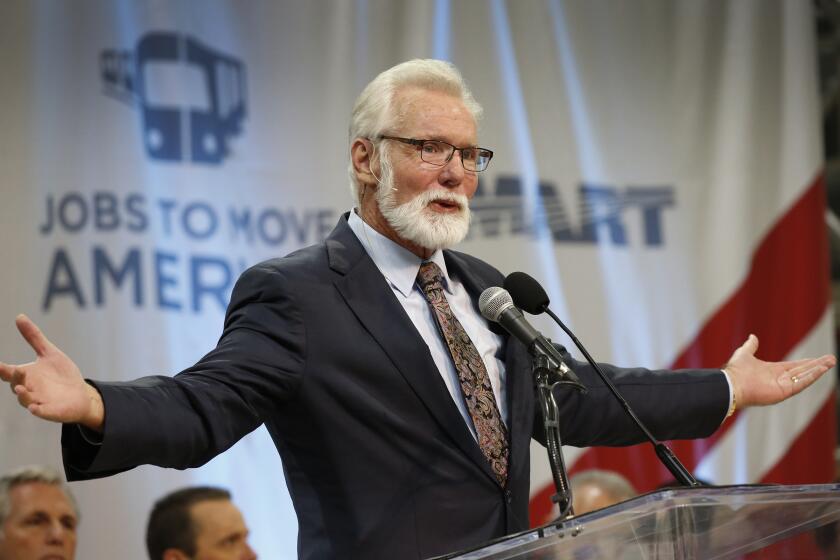A case study in L.A.’s crumbling infrastructure
- Share via
If there were a poster child for the state of municipal services in Los Angeles, it would be a beleaguered Louise Bianco of Tarzana.
Mrs. Bianco, 86, is no slave to the sofa. She gets up and goes, every morning, despite visual impairment, hip replacements, a bad knee and wobbly balance. Unable to drive a car, she straps on a helmet and takes her three-wheel bicycle out for a one-hour workout to start the day, then uses the same bike to run errands or go to her fitness class at Pierce College.
“I have 14,922 miles on my odometer,” she told me Monday morning as she pedaled from her backyard to the alley behind her house, where she has lived for 59 years.
But that alley — which Bianco uses to get to the Orange Line bikeway — is a mess. It’s cracked, it’s weed-infested, it dips, it dives, and Mrs. Bianco is afraid she’s going to get bucked off her bike one day.
For years, Mrs. Bianco has been asking City Hall for help. But she’d have had better luck writing to the North Pole and asking Santa for an asphalt mixer and a bulldozer.
“We ... have tried to get our alley repaired for decades!” she wrote in an email to her council office, speaking not just for herself, but for her late husband, Angelo, a longtime LAUSD teacher whom she lost about a year ago.
“My husband even walked to Zine’s office trying to get his attention in years past!” Mrs. Bianco wrote. She was referring to former Councilman Dennis Zine, who held the District 3 office from 2001 to 2013, when Bob Blumenfield succeeded him.
Those of you who follow the news out of City Hall are no doubt aware of several realities working against Mrs. Bianco.
First and foremost, about 40% of the city’s several thousand miles of streets are in such bad shape, with grades of D or F, that the city has virtually given up on them because the repairs would cost billions. And as we learned with the water main rupture on Sunset Boulevard two weeks ago, it would cost billions more to replace the ancient water delivery system.
In the scheme of things, a buckling alley doesn’t have a chance.
Meanwhile, neither Mayor Eric Garcetti nor the City Council have been willing or able to outline a plan by which they can begin to make any significant headway on Garcetti’s promise to deliver the kinds of basic services residents deserve and demand.
“It seems to me the city has neglected everything from time immemorial,” said Bianco’s son, Todd, who lives in West Hollywood and drives his mother to the places she can’t ride her bike to.
Todd noted city officials have considered and dismissed a sales-tax increase and bond measure, among other revenue-raising schemes. While he understands the politics, he’d like to see a little leadership on whatever alternatives there might be.
“While I support Garcetti, I think he’s been MIA,” said Todd. “Back to basics is all well and good, but it’s hard to see where it’s going to come from and how it’s going to be implemented.”
Indeed, I’m sorry to have to say the chance of Mrs. Bianco getting her alley fixed is no better than the chance of her riding the three-wheeler to victory in next year’s Tour de France.
And yet she couldn’t resist a shot to give it one more try after reading City Controller Ron Galperin’s scathing op-ed on streets department mismanagement in last week’s Times.
Among myriad problems, Galperin identified accounting failures, a lack of common-sense prioritization, an asphalt-making operation that costs more per ton than if the city bought it privately, and $190 million in uncollected fees.
And yet Mrs. Bianco saw hope in Galperin’s call for greater efficiency and accountability, thinking this might be her best chance to get the alley paved. She emailed The Times to alert us to her cause, and when I got to her house, she was prepared with her life story and freshly baked cookies.
She couldn’t wait to show me the hazards she faces pedaling her bike along the alley, where she’s had to figure out the safest route over the rocky terrain.
Even so, “one of the two back wheels is off the ground sometimes,” Mrs. Bianco said. And she can’t pedal out front and use the sidewalk because the bike is too wide to get through her gate.
Mrs. Bianco may not have all the answers on city finances, but she had a few sharp observations. Proposition 13 was a big help to her back in 1978, she said. But it delivered a blow to local services, and she thinks it should be tweaked now, in part to undo the way in which corporations use legal maneuvers to avoid reassessments.
She supports hardworking public employees, but noted that their unions have used influence on politicians to win pension deals that are squeezing revenues for basic services. And she wonders why we were building infrastructure in Iraq and Afghanistan while neglecting our own needs.
On June 26, Bianco says, she sent an email and a photo of the alley to Councilman Blumenfield’s office and did not get a response. When I called the office and asked why, I was referred to spokesman Jason Levin. He said a staffer visited Bianco’s alley last October at her request and the office is “working to see if there’s a solution,” but “at the moment the city has limited resources.”
Mrs. Bianco may be an extremely frustrated taxpayer, but she’s also a reasonable woman.
“Just give me a 3-foot-wide strip” of fresh asphalt, she said, if not an entire new alley. “That’s all I need.”
More to Read
Sign up for Essential California
The most important California stories and recommendations in your inbox every morning.
You may occasionally receive promotional content from the Los Angeles Times.











